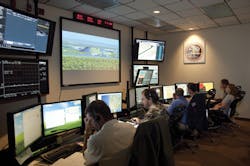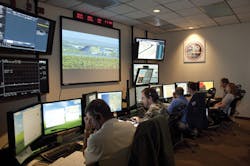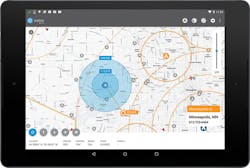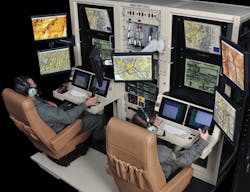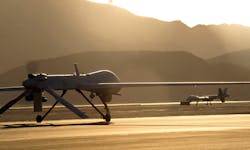The challenge of controlling proliferating unmanned aircraft
Unmanned aerial vehicles (UAVs) are in common usage in the U.S. military, yet systems designers struggle with developing universal UAV control systems that are simple and reliable to operate.
BY J.R. Wilson
The technological revolution that began in the latter half of the 20th Century was largely hardware-based, from computers to communications to combat. That began to change as the 1990s drew to a close and software began taking on a greater role in providing upgraded capabilities on existing hardware.
The software-defined radio (SDR) generally is cited as the principle example of that, but in recent years it has expanded to include items such as software-defined radar, sonar, and software-defined unmanned vehicle (UXV) control systems.
Software-defined unmanned vehicle control is an adaptation that will better enable the long-sought goal of common controllers as the number and type of unmanned aerial vehicles (UAVs) continues to grow across all four military services - and soon will include unmanned ground vehicles (UGVs) and unmanned underwater vehicles (UUVs). But the greater the reliance on software controls, onboard and remote, the greater the potential hazards.
"You can't assume anything is going to be the same from minute-to-minute," warns S. Tucker Taft, vice president and director of language research at software specialist AdaCore in New York.
Nevertheless, there is general agreement that the future of UXV control systems revolves around software.
"We're there today; SDR is a perfect analogy for just about any effort in the virtual space," says Todd Probert, vice president of mission support and modernization at Raytheon Intelligence, Information, and Services in Dulles, Va. "There will still be things that are physics-defined, but more and more capability is migrating to the software-defined space. The state of technology is very robust and evolving very quickly. It comes down to figuring out how to actually employ those CONOPs in the warfighting domain."
Cooperating unmanned vehicles
The ability to swarm UAVs is a major capability that software-defined control systems enable. "We have architecture controlling a swarm rather than each individual UAV," Probert says. "The Navy may want a number of different types of unmanned systems on the same ship, but because SWaP [size, weight and power] is a precious commodity, they don't want separate control systems for each. You can train a sailor on that architecture alone and it also is easier to maintain, so the economies of scale make a lot of sense."
There remain barriers to implementing common controls, especially across industry and between services. These barriers include the need to abandon proprietary elements; the need to trust others with software creation; concerns about security, at the manufacturing level and in the field; and the establishment and acceptance of standards.
"It's hard to gauge commitment on this," says Kingsley Fregene, group leader of robotics and intelligent systems at Lockheed Martin Advanced Technology Laboratories in Cherry Hill, N.J. "Almost everyone recognizes it is not ideal to have a separate controller for everything that is being fielded. It makes a lot of sense to have a common controller for a large category of systems, if not all systems. And that's where there are various opportunities going on."
Universal unmanned vehicle controllers still are in their infancy, experts say. "Developing a single controller for UAVs and UGVs is still in the early stages," Fregene says. "The technology operators recognize it is important to use a common controller across domains, but that effort is at a much earlier stage than the efforts to develop common controllers for specific types of UXVs - air vehicles or maritime or ground."
Leaders of the U.S. military services already are collaborating more broadly on a key element - the development open architectures and standards for UXV control systems, Raytheon's Probert says.
"From a CONOPs standpoint, I think we will see the ability to do that across services and domains in the near future," Probert continues. "It is very conceivable that as architecture collapses down, some general somewhere could have capability on his or her smartphone to handle a UAV."
Promising technologies for universal unmanned vehicle controllers could be closer than many people think. "If the state of technology is not there today, it is very near the tipping point," Probert says. "That's what is happening in this open-architecture environment and it's a key enabler because we only have to build the platform once. And we can build cyber resiliency into that open architecture as the threat evolves, as well."
The need for standards
While agreeing the future of UXV control systems lies with advanced software, Lockheed Martin's Fregene says cross-platform and inter-service systems won't happen without standardization.
"There is a lot of progress being made in trying to achieve unification, but we're not all the way there yet. It's a challenge because there are many different vendors and types of platforms and no agreed-upon standard everyone uses," Fregene explains. "There are committees meeting, from the STANAG [NATO Standardization Agreement] standards defining data flow to JAUS [Joint Architecture for Unmanned Systems], on how to allow systems to interact. Some are looking at air vehicles, some ground, some maritime. Those need to be brought together to have a truly unified standard in the future. Most recently, the Navy Science and Technology committee at NRL [the Naval Research Laboratory in Washington] has been trying to take the standards developed for air vehicles and customize them for maritime vehicles."
While software-defined controls are less expensive, easier to maintain and upgrade, require less user training, and can be adapted to changing mission requirements -perhaps literally on-the-fly - they also open the platforms involved to greater enemy threats. It requires physical access to compromise an electronic component, but in cyberspace, the hacker and her target can be on opposite sides of the world.
Researchers at the U.S. Defense Advanced Research Projects Agency (DARPA) in Arlington, Va., have begun looking into how to survive such an attack with the agency's High-Assurance Cyber Military Systems (HACMS) project to enable high-assurance military systems, including UXVs and command and control systems.
"Achieving this goal requires a fundamentally different approach from what the software community has taken to date," DARPA officials say. "Consequently, HACMS will adopt a clean-slate, formal methods-based approach to enable semi-automated code synthesis from executable, formal specifications.
"In addition to generating code, HACMS seeks a synthesizer capable of producing a machine-checkable proof that the generated code satisfies functional specifications as well as security and safety policies," DARPA officials continue. "A key technical challenge is the development of techniques to ensure that such proofs are composable, allowing the construction of high-assurance systems out of high-assurance components."
Reliable software
One of those working on that concept is AdaCore, where Taft says intelligent control systems for autonomous vehicles is where the software becomes extremely important.
"And the biggest challenge is not so much the control system, which typically has a human operator, but in security of transmission and the reliability of remote sensors and the connection between the remote pilot and the vehicle," Taft explains, adding another rapidly developing element, artificial intelligence, expected to play a role in future UXVs creates issues more basic than fears of "Terminators" taking to the battlefield.
Indeed, those working on artificial intelligence (AI)-based control systems believe AI will have the opposite effect - creating greater human control.
"AI is great, but has to be paired with a system that has simple controls," Taft says. "By itself, it is too hard to feel confident about it at this time. I think we will start understanding what AI can and cannot do - and it won't be as helpful as hoped in some areas. It will augment, not replace, human input; it will deal with the details and the human with the higher-level decisions."
Lockheed Martin also is working on systems that will improve the integration of man and machine.
"Traditionally, we've had a mix of in-house command stations and those from other sources. Right now, there is a trend to put together a command and control [C2] station especially for UAVs, pulling in different capabilities and unifying the way you interact with these vehicles," Fregene says. "On the research and development side, there is a strong interest in developing C2 stations with the ability for humans and machines to interact - human and robot teaming. So control stations that require the human to be head-down, looking at the screen almost all the time, are being replaced by devices that can be worn on the body, head-up displays, etc., to make these interactions a lot easier."
Fregene agrees, saying human operators will remain important to all future UXV control systems, no matter the level of autonomy involved.
Human-machine teams
"There is a big emphasis on determining the best way for humans and robots to form teams, which presuppose some type of interaction, from having enough onboard autonomy that the functionality required on the control station is minimal to something similar to what we have today with many systems remotely controlled," Fregene explains. "As we increase the level of autonomy we put on these systems, it won't remove the need to have a human. The goal is not to have systems that operate with no human involvement at all. What needs to happen is to understand how team dynamics work. Increasing autonomy will help with how we do control stations by reducing the need to put in a lot of functionality for total human control."
From a control systems standpoint, then, AI is an important component in expanding the abilities of human operators to control UXVs in the future.
"Right now, it takes 10 people to control one drone," says Jim Crowder, chief engineer at Raytheon Intelligence, Information, and Services, who is helping to pioneer AI technologies. "What we'd like to get to is one guy controlling 10 drones."
The U.S. Air Force already is moving forward with that concept with a new UAV Block 50 ground control station that enables one operator to perform functions now done by multiple operators. The Block 50 also will incorporate open architecture, allowing it to integrate new software as technologies continue to evolve.
One operator using these advanced control systems could be a submariner, an infantryman or a fighter pilot, each controlling multiple UUVs, UGVs, or UAVs - and, eventually, combinations of those platforms, regardless of service ownership. Such unified control would speed the delivery of information from the UXV directly to the human controller, without going through a dedicated ground control system first, and new orders from that human to individual UXVs or even a swarm.
Having a human controller in the same battlespace also makes the UXVs more agile, eliminating the up to two-second delay in commands sent from a control station half the world away. The key is to make the unmanned platform and its onboard controller sufficiently autonomous and able to process and fuse data onboard that the human controller only receives what is absolutely necessary to his or her decision-making, without being overwhelmed.
The role of hardware
Although the future of UXV control systems commonality is tightly bound to software developments, that does not mean advances in hardware are no longer needed or relevant - especially if some remote systems are worn by warfighters. As those systems become smaller and proliferate, they raise new problems - and potential software solutions - of their own.
"Power has emerged as an important aspect, in some ways impacting Moore's Law because if you want twice the speed, you need more power. At some point, you need to concentrate on low-power systems, especially during those times when you don't need the highest levels of performance," says AdaCore's Taft. "We have smartphones today that can do a lot of tasks and can be ruggedized and given to soldiers. Or the soldier could wear a tracker and the UGV would simply follow. But what happens when controls worn or carried by a soldier get captured by the enemy? You have to be able to detect quickly when that happens, which means a monitor on every soldier that can shut the system down if things go off the rails."
A growing reliance on software- defined systems also means a growing reliance on having the best programmers available - far more skilled at creating error-free software than ever before.
That is an area that greatly concerns Taft. "The actual process of creating software is still pretty primitive. There is a push toward so-called model-based development, which we're trying to support among our customers, but in my own view, that is still pretty low-level. I'm in the programming language research business and I don't think we've reached the end of that road.
"It's not just a question of how quickly you can produce a program that does the right thing, but creating a program that does it with safety and security. In almost every engineering classification, you have to get certified - but not in the software field. And as more and more of our systems become software-centric, it is alarming that so many parts of these systems are being built by people who have no real certified background."
As research organizations such as AdaCore, Lockheed Martin, Raytheon, DARPA, and NRL enhance and expand their efforts on future UXV control systems, technologies will need to move forward. Fregene addressed some of those:
Displays
"There are some very interesting technologies that are leading to displays that are conformal, meaning they can change shape to fit. Those are in the early stages, but will be critical to meeting the need for control stations that are less burdensome than what we have today."
Batteries (or alternative power sources)
"There is a lot of work being done there, including early research into embedding some materials in the boots of operators so they can generate some quantity of power just by their usual movements and walking around."
Power electronics
"Many systems will have power electronic components that are built-in, to manage consumption or channel power directly to device sub-elements, for example. There is no one way to address the broad subject of power, including finding ways to control it. But ways will be found to be more efficient with the processes already being used as we tackle them from all directions."
Wireless networking
"Wireless networks are pretty well understood in terms of the protocols we have today. New questions include how much can we package into these channels and how well can we secure them. Operators will almost be like nodes on a wireless network. So there will need to be some new foundational technologies developed to address the issues surrounding wireless."
Microprocessors
"There are different processing techniques being developed that have very little power consumption; neuromorphic processors meant to in some sense imitate how the human neural system works and reduce power consumption."
Nanotech
"Nanotech is another enabling technology; using nanotech fabrication techniques, for example, can enable new processors to become more viable."
SWaP-C
"SWaP is important in onboard and remote control systems. If you have something flying, weight impacts how long and far it can fly. So managing SWaP-C is critical to what you put out there. There is a finite amount of power available and the longer time-on-station you can have for your system, the better.
"For remote controllers on the ground, SWaP-C is still important because they take up space and resources, especially in expeditionary applications. So it will continue to be an important consideration for any future systems."
Artificial intelligence
"A lot of good work has happened in AI in the last five years or so, a lot enabled by so-called deep learning. There are many autonomous systems and the goal is to have systems with their own ability to make decisions in response to what they encounter in the field. Deep learning, which is driving AI today, is being developed directly in the processing architecture. Today we write algorithms that run on a processor, but if we can run those algorithms directly, using a deep learning architecture, we will see the promise of AI. Deep learning, enabled by the ability to do direct onboard implementation, will go a long way toward accomplishing that."
Autonomous activity
In February 2017, the U.S. Navy underwent a massive reorganization of its unmanned underwater platform programs structure, disbanding the year-old Unmanned Warfare Systems Directorate and moving all its unmanned systems into technology development or domain-based warfare directorates.
The Navy said no current programs of record will be cut, slowed, or otherwise affected, but will be more completely integrated across domains. Among those affected are the Common Control System (CCS) and Common System Interface, which enables CCS communication with existing system interfaces.
In 2016, tests of the CCS with a Large Displacement Unmanned Undersea Vehicle demonstrated it could provide command, control, planning, and monitoring from one global operations center to UUVs on missions anywhere in the world and is adaptable to UUV and UAV missions, according to program officials at Patuxent River, Md. The Navy's ultimate goal is to field the CCS across all domains and platforms - air, land, sea, and undersea - simultaneously.
"I think there will be more and more autonomy, but paired with high-level control. You give it a mission and it does its best to achieve that, but fundamentally it is trying to control a system at a much higher level than we've been used to. But even if fully autonomous, UXVs will depend on external connections of some sort, to know where other units are, to receive information. That is the big challenge," Taft says. "You have a very noisy space and people trying to make it even noisier. So you have to come up with algorithms to compensate; the systems have to be very adaptive and can't assume one level of communication and connection. They also must be able to validate the data they are receiving, because the inputs may be misleading, intentionally or otherwise. Safety and security are no longer as separate as they used to be."
As new UXV control systems technologies evolve, changing military CONOPs and expanding capabilities, potential adversaries are working hard on ways to disrupt and defeat what, until now, has been total U.S. dominance in the field of unmanned platforms.
"The biggest space is cyber, not just for unmanned but for all C2 and ISR systems. Cyber is a key element we need to contend with going forward and make sure we can manage alongside the functionality and capability of these systems," Probert concludes. "We are building foundational open architecture that includes the ability to evolve from a cyber resilience standpoint. But once we close down an avenue of attack, the persistent threat out there finds two or three new ways to attack, so you have to build your architecture with that in mind.
"What happens with UXV control systems, onboard and remote, in the next 5 to 10 years is very much about analytics, automation, and cyber. The world is quickly going to a virtualized environment, where it doesn't really matter where the UXV control system resides. Technology has increased almost exponentially in the last five years - and that will continue. The battlespace is becoming digitized and that digitization is driving the speed of war in ways we can't even imagine."
